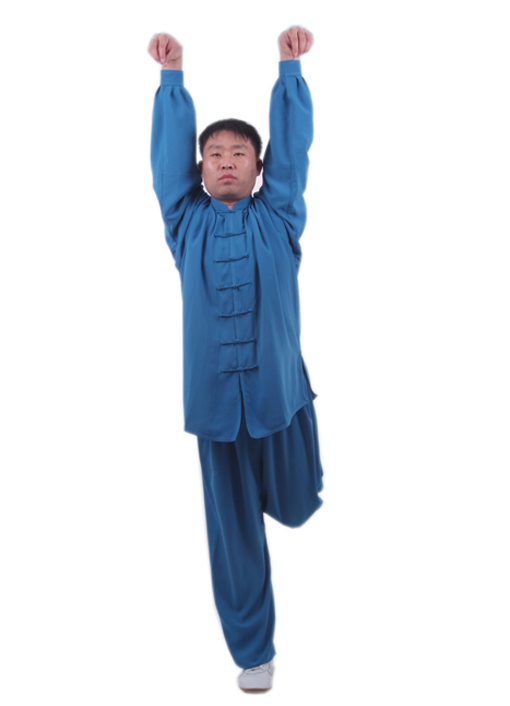
An ancient poem read: “The home is so comfortable that the golden rooster comes to herald the dawn and the phoenix comes to rest in the yard.” “Golden Rooster Heralds the Dawn (Jin Ji Bao Xiao)” is the eighth routine of Health Qigong Daoyin Yang Sheng Gong Shi Er Fa. The routine gets its name because it includes the movements of standing on one leg with the other leg pulled up and stretched backward and palms raised in the shape of a hook. These movements imitate the posture of the golden rooster heralding the dawn.
Chinese Folk Mascots Series wrote: “The hen lays eggs and the rooster crows.” They have their own different contributions. The rooster is also one of the twelve Chinese zodiacs. At least, people born in the year of the rooster have special sentiment to this bird because it is their mascot. The rooster is welcomed and valued by the Chinese people because of its marvelous experience and virtues. It is recorded that the rooster has five kinds of virtues. The red cockscomb on its head makes it elegant. The humps on its heels make it strong. It is brave enough to fight its enemy, benevolent enough to call other chicken and share the food it found, and honest enough to give the right time.
The rooster is treated as the sign of strength and courage because it is brave to fight and good at fighting. The rooster has a big and crimson cockscomb, just like the official’s crown, so it is treated as a propitious sign indicating getting a high post. “The rooster’s call” indicates someone getting high position and fame. A picture with roosters and prince's-feathers can be used to congratulate people who continually get promotions. A picture with a rooster and five chicks has the meaning of “all the children in the family are well-educated”. In some places in China, every family keeps a red rooster and believes that it can prevent fire hazards. These examples all show that the Chinese people treat the rooster as a mascot of courage and virtue. Just as the famous poet Tang Yin living in the Ming dynasty wrote in his poem Portraying the Rooster: “Its read crown need not be pruned. It walks towards me in pure white. Although it is usually prudent to talk, all residents open their windows when it heralds the dawn.”
Li He, the poet living in the Tang dynasty also wrote: “I want to find a lost spirit but failed, just then the rooster called, bringing the bright day to the world.” This poem described that the rooster’s call is a sign of the ending of the long night and the starting of a brand-new day.
Now let’s have a look at the four functions of “Golden Rooster Heralds the Dawn” from the routine’s movement structure.
I. Raising palms in the shape of a hook can help dredge the Yuan-source points and Jing-well points on the three yin meridians and three yang meridians of hand.
According to TCM theories, the Taiyuan Point is the Yuan-source point of the lung meridian of hand-taiyin, and the Shaoshang Point is the Jing-well point of this meridian. The Daling Point is the Yuan-source point of the pericardium meridian of hand-jueyin, and the Zhongchong Point is the Jing-well point of this meridian. The Shenmen Point is the Yuan-source point of the heart meridian of hand-shaoyin, and the Shaochong Point is the Jing-well point of this meridian. The Hegu Point is the Yuan-source point of the large intestine meridian of hand-yangming, and the Shangyang Point is the Jing-well point of this meridian. The Wangu Point is the Yuan-source point of the small intestine meridian of hand-taiyang, and the Shaoze Point is the Jing-well point of this meridian. These Yuan-source points and Jing-well points are all located near the wrist joints or the fingertips. Research shows that when the exerciser repeats the movements in “Golden Rooster Heralds the Dawn” such as pinching the fingers, bending the arms and holding them up, the Jing-well points can be stimulated at a certain extent, promoting the flow of qi and blood. This follows the principles recorded in Lingshu: “Stimulate the twelve Yuan-source points and the Jing-well points when you have visceral illnesses.” The movements can also improve the function of the viscera at a certain extent, strengthen the lung and the heart, dredge the triple energizers, smooth the intestines and eliminate the clogs.
II. Bending the body backward can help dredge the Governor Vessel, the Conception Vessel and the twelve meridians, improving one’s constitution.
According to TCM theories, the Governor Vessel starts from the abdominal cavity, goes out the perineum, goes through the spine, rises up to the Fengfu Point on the back side of the neck, enters the cranium, and winds the brain. The Conception Vessel starts from the abdominal cavity, goes out the perineum, travels through the pubes, rises up along the center line of the abdomen and the chest to the throat.
When doing the movements in “Golden Rooster Heralds the Dawn”, the exerciser repeatedly bends his body backward into a bow's shape. The Governor Vessel goes through the spine and belongs to the kidney. This vessel and its six yang meridians have the job of leading and promoting the yang qi. The Conception Vessel and its six yin meridians have the duty of nourishing the yin qi in the whole body. The movements above can improve the effect of these jobs, realizing the effects of “dredging the Conception Vessel and the Governor Vessel to dredge all other vessels”, “accumulating enough essence and qi, nourishing the sea of marrows” and strengthening the whole body.
(By Zhang Guangde and Si Chaoquan)

